Digital Marketing's Influence on Consumer Buying Behavior: A Study
VerifiedAdded on 2024/07/01
|37
|7137
|354
Project
AI Summary
This research project investigates the influence of digital marketing on the buying behavior of consumers, specifically focusing on Timeless Travels Ltd. The study employs a mixed-methods approach, utilizing both qualitative and quantitative data collection techniques. A structured questionnaire was distributed among 135 participants, with 100 completed questionnaires selected for analysis, complemented by secondary data from journals and previous studies. The research aims to ascertain the usage of digital marketing tools by Timeless Travels Ltd, analyze the impact of digital marketing on changing consumer behavior, and identify the link between digital marketing and customer satisfaction. The project addresses the problem of adapting to the evolving tastes and preferences of travelers in the tourism industry and seeks to understand how digital marketing strategies can effectively influence their buying decisions. The findings provide insights into the relationship between digital marketing efforts and consumer behavior within the context of the travel and tourism sector.
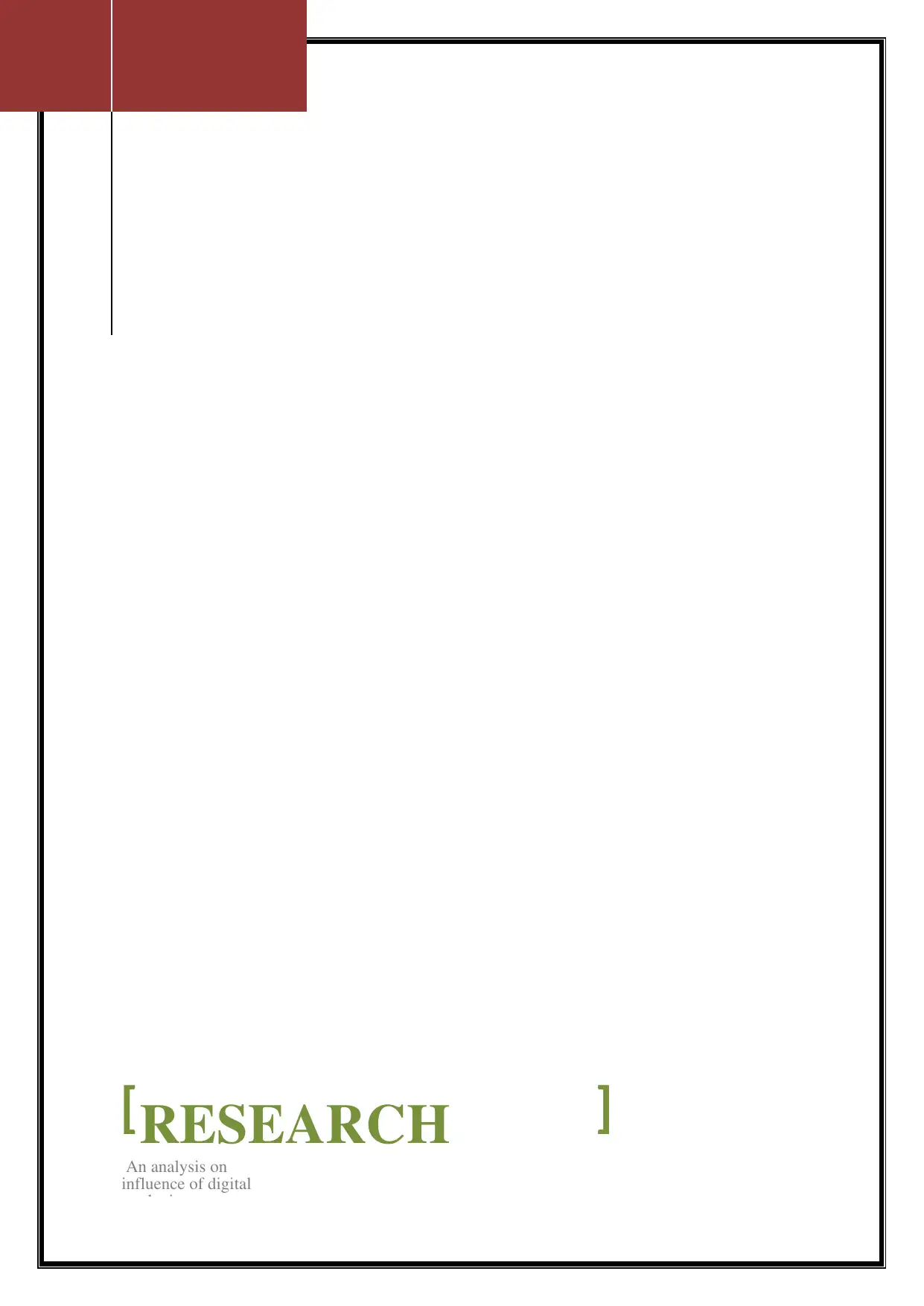
[ ]
Paraphrase This Document
Need a fresh take? Get an instant paraphrase of this document with our AI Paraphraser
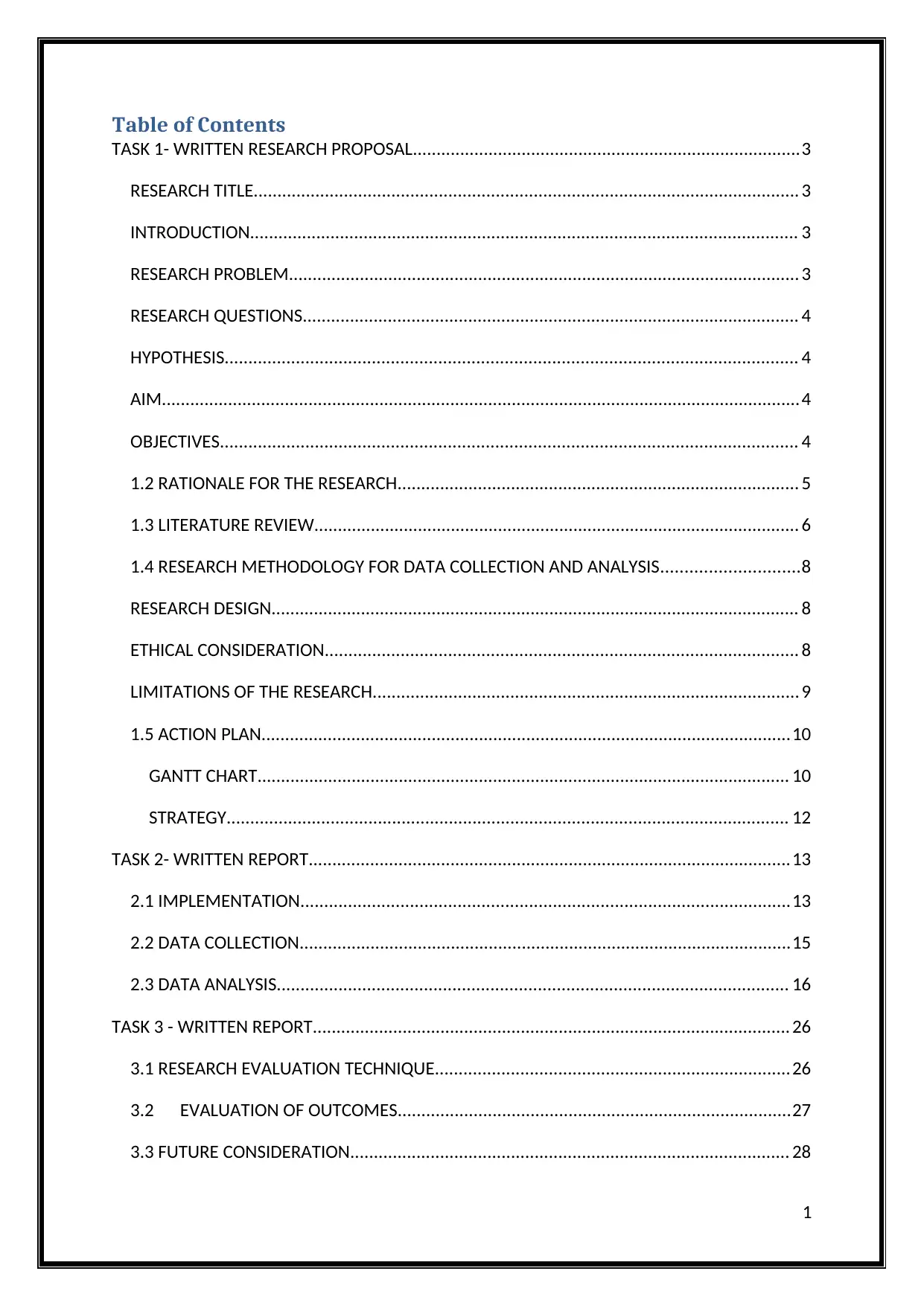
Table of Contents
TASK 1- WRITTEN RESEARCH PROPOSAL..................................................................................3
RESEARCH TITLE................................................................................................................... 3
INTRODUCTION.................................................................................................................... 3
RESEARCH PROBLEM............................................................................................................ 3
RESEARCH QUESTIONS......................................................................................................... 4
HYPOTHESIS......................................................................................................................... 4
AIM.......................................................................................................................................4
OBJECTIVES.......................................................................................................................... 4
1.2 RATIONALE FOR THE RESEARCH..................................................................................... 5
1.3 LITERATURE REVIEW....................................................................................................... 6
1.4 RESEARCH METHODOLOGY FOR DATA COLLECTION AND ANALYSIS.............................8
RESEARCH DESIGN................................................................................................................ 8
ETHICAL CONSIDERATION.................................................................................................... 8
LIMITATIONS OF THE RESEARCH.......................................................................................... 9
1.5 ACTION PLAN................................................................................................................10
GANTT CHART................................................................................................................. 10
STRATEGY....................................................................................................................... 12
TASK 2- WRITTEN REPORT......................................................................................................13
2.1 IMPLEMENTATION.......................................................................................................13
2.2 DATA COLLECTION........................................................................................................15
2.3 DATA ANALYSIS............................................................................................................ 16
TASK 3 - WRITTEN REPORT..................................................................................................... 26
3.1 RESEARCH EVALUATION TECHNIQUE...........................................................................26
3.2 EVALUATION OF OUTCOMES...................................................................................27
3.3 FUTURE CONSIDERATION............................................................................................. 28
1
TASK 1- WRITTEN RESEARCH PROPOSAL..................................................................................3
RESEARCH TITLE................................................................................................................... 3
INTRODUCTION.................................................................................................................... 3
RESEARCH PROBLEM............................................................................................................ 3
RESEARCH QUESTIONS......................................................................................................... 4
HYPOTHESIS......................................................................................................................... 4
AIM.......................................................................................................................................4
OBJECTIVES.......................................................................................................................... 4
1.2 RATIONALE FOR THE RESEARCH..................................................................................... 5
1.3 LITERATURE REVIEW....................................................................................................... 6
1.4 RESEARCH METHODOLOGY FOR DATA COLLECTION AND ANALYSIS.............................8
RESEARCH DESIGN................................................................................................................ 8
ETHICAL CONSIDERATION.................................................................................................... 8
LIMITATIONS OF THE RESEARCH.......................................................................................... 9
1.5 ACTION PLAN................................................................................................................10
GANTT CHART................................................................................................................. 10
STRATEGY....................................................................................................................... 12
TASK 2- WRITTEN REPORT......................................................................................................13
2.1 IMPLEMENTATION.......................................................................................................13
2.2 DATA COLLECTION........................................................................................................15
2.3 DATA ANALYSIS............................................................................................................ 16
TASK 3 - WRITTEN REPORT..................................................................................................... 26
3.1 RESEARCH EVALUATION TECHNIQUE...........................................................................26
3.2 EVALUATION OF OUTCOMES...................................................................................27
3.3 FUTURE CONSIDERATION............................................................................................. 28
1
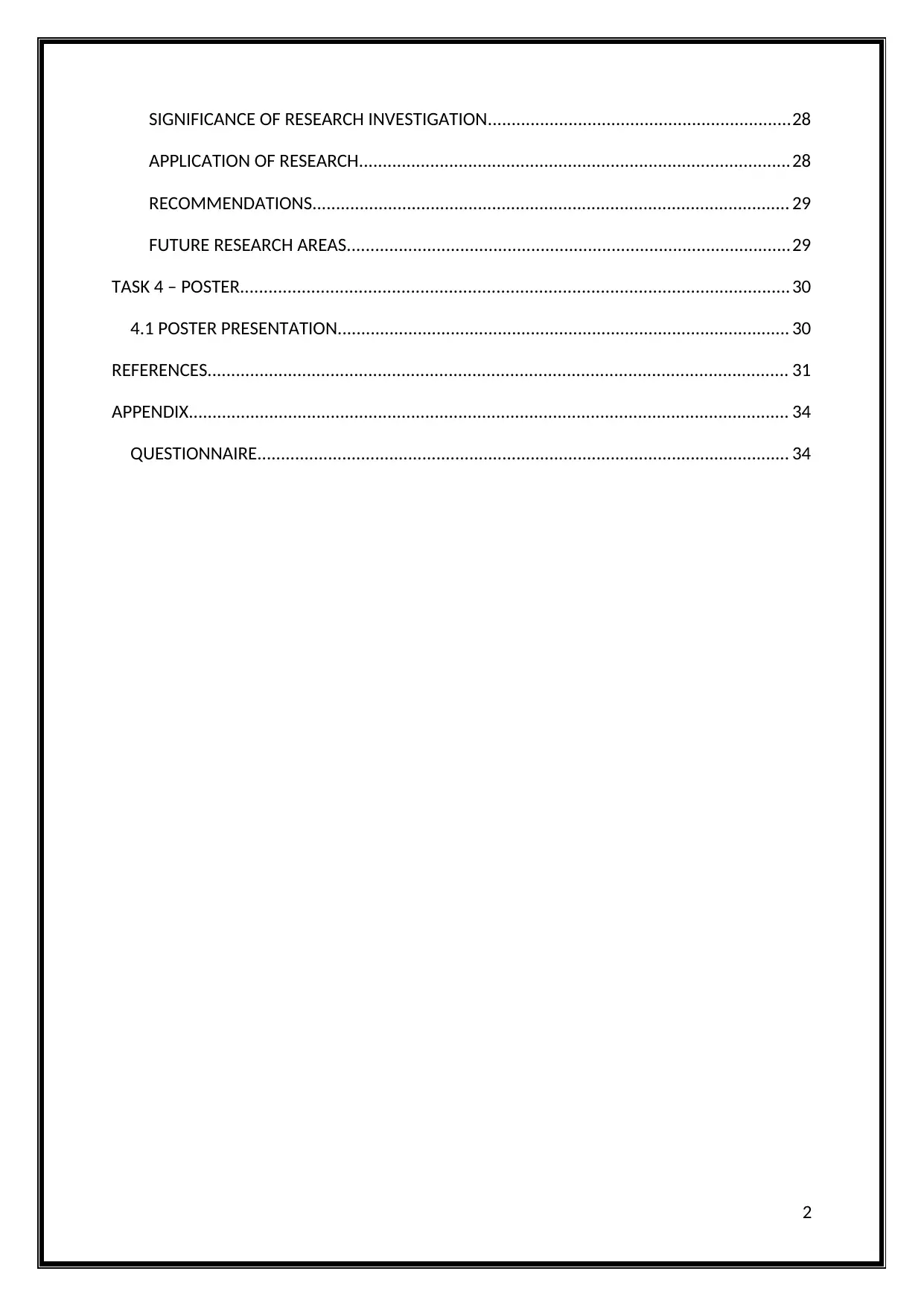
SIGNIFICANCE OF RESEARCH INVESTIGATION................................................................28
APPLICATION OF RESEARCH...........................................................................................28
RECOMMENDATIONS..................................................................................................... 29
FUTURE RESEARCH AREAS..............................................................................................29
TASK 4 – POSTER.................................................................................................................... 30
4.1 POSTER PRESENTATION................................................................................................ 30
REFERENCES........................................................................................................................... 31
APPENDIX............................................................................................................................... 34
QUESTIONNAIRE................................................................................................................. 34
2
APPLICATION OF RESEARCH...........................................................................................28
RECOMMENDATIONS..................................................................................................... 29
FUTURE RESEARCH AREAS..............................................................................................29
TASK 4 – POSTER.................................................................................................................... 30
4.1 POSTER PRESENTATION................................................................................................ 30
REFERENCES........................................................................................................................... 31
APPENDIX............................................................................................................................... 34
QUESTIONNAIRE................................................................................................................. 34
2
⊘ This is a preview!⊘
Do you want full access?
Subscribe today to unlock all pages.

Trusted by 1+ million students worldwide
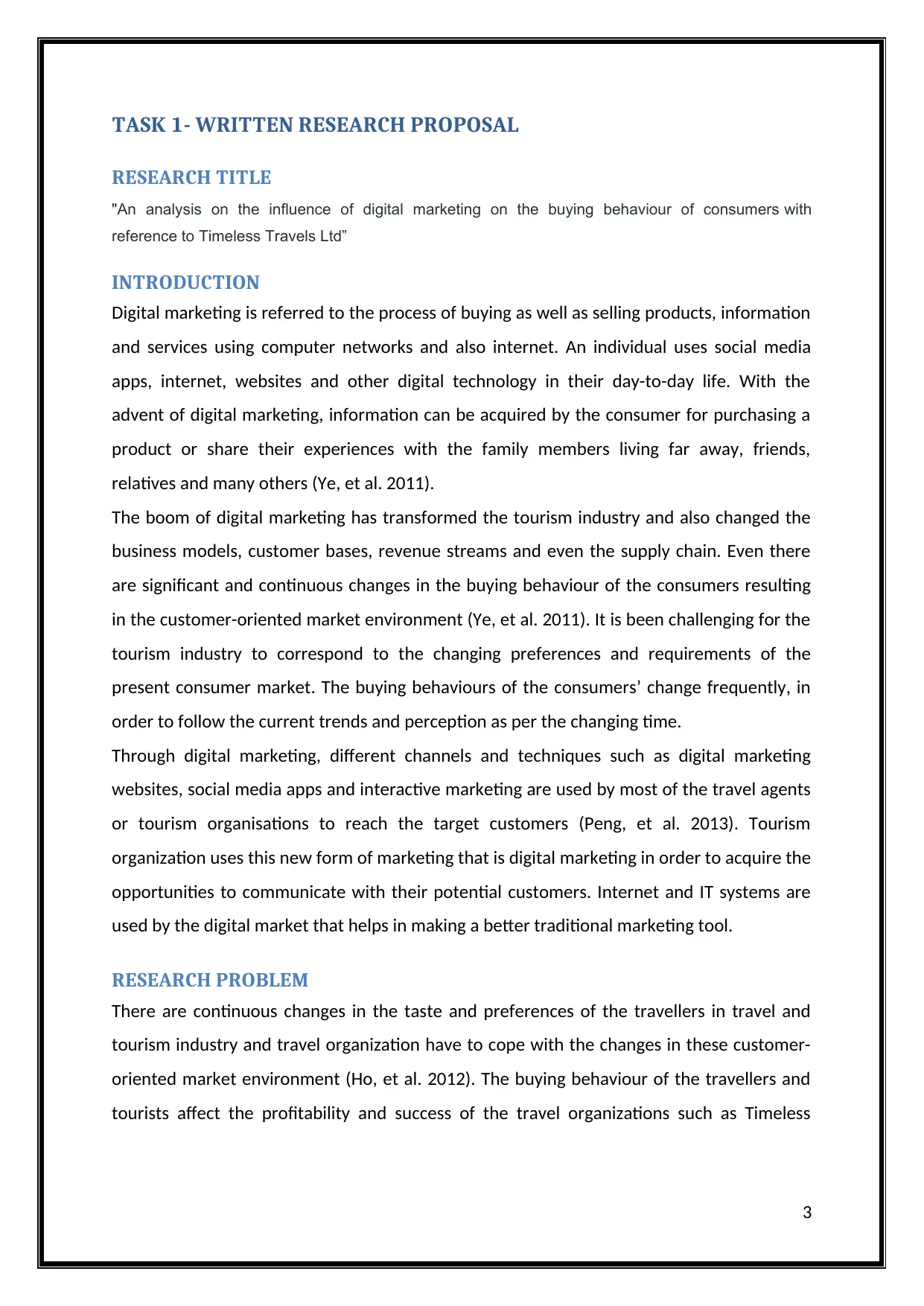
TASK 1- WRITTEN RESEARCH PROPOSAL
RESEARCH TITLE
"An analysis on the influence of digital marketing on the buying behaviour of consumers with
reference to Timeless Travels Ltd”
INTRODUCTION
Digital marketing is referred to the process of buying as well as selling products, information
and services using computer networks and also internet. An individual uses social media
apps, internet, websites and other digital technology in their day-to-day life. With the
advent of digital marketing, information can be acquired by the consumer for purchasing a
product or share their experiences with the family members living far away, friends,
relatives and many others (Ye, et al. 2011).
The boom of digital marketing has transformed the tourism industry and also changed the
business models, customer bases, revenue streams and even the supply chain. Even there
are significant and continuous changes in the buying behaviour of the consumers resulting
in the customer-oriented market environment (Ye, et al. 2011). It is been challenging for the
tourism industry to correspond to the changing preferences and requirements of the
present consumer market. The buying behaviours of the consumers’ change frequently, in
order to follow the current trends and perception as per the changing time.
Through digital marketing, different channels and techniques such as digital marketing
websites, social media apps and interactive marketing are used by most of the travel agents
or tourism organisations to reach the target customers (Peng, et al. 2013). Tourism
organization uses this new form of marketing that is digital marketing in order to acquire the
opportunities to communicate with their potential customers. Internet and IT systems are
used by the digital market that helps in making a better traditional marketing tool.
RESEARCH PROBLEM
There are continuous changes in the taste and preferences of the travellers in travel and
tourism industry and travel organization have to cope with the changes in these customer-
oriented market environment (Ho, et al. 2012). The buying behaviour of the travellers and
tourists affect the profitability and success of the travel organizations such as Timeless
3
RESEARCH TITLE
"An analysis on the influence of digital marketing on the buying behaviour of consumers with
reference to Timeless Travels Ltd”
INTRODUCTION
Digital marketing is referred to the process of buying as well as selling products, information
and services using computer networks and also internet. An individual uses social media
apps, internet, websites and other digital technology in their day-to-day life. With the
advent of digital marketing, information can be acquired by the consumer for purchasing a
product or share their experiences with the family members living far away, friends,
relatives and many others (Ye, et al. 2011).
The boom of digital marketing has transformed the tourism industry and also changed the
business models, customer bases, revenue streams and even the supply chain. Even there
are significant and continuous changes in the buying behaviour of the consumers resulting
in the customer-oriented market environment (Ye, et al. 2011). It is been challenging for the
tourism industry to correspond to the changing preferences and requirements of the
present consumer market. The buying behaviours of the consumers’ change frequently, in
order to follow the current trends and perception as per the changing time.
Through digital marketing, different channels and techniques such as digital marketing
websites, social media apps and interactive marketing are used by most of the travel agents
or tourism organisations to reach the target customers (Peng, et al. 2013). Tourism
organization uses this new form of marketing that is digital marketing in order to acquire the
opportunities to communicate with their potential customers. Internet and IT systems are
used by the digital market that helps in making a better traditional marketing tool.
RESEARCH PROBLEM
There are continuous changes in the taste and preferences of the travellers in travel and
tourism industry and travel organization have to cope with the changes in these customer-
oriented market environment (Ho, et al. 2012). The buying behaviour of the travellers and
tourists affect the profitability and success of the travel organizations such as Timeless
3
Paraphrase This Document
Need a fresh take? Get an instant paraphrase of this document with our AI Paraphraser
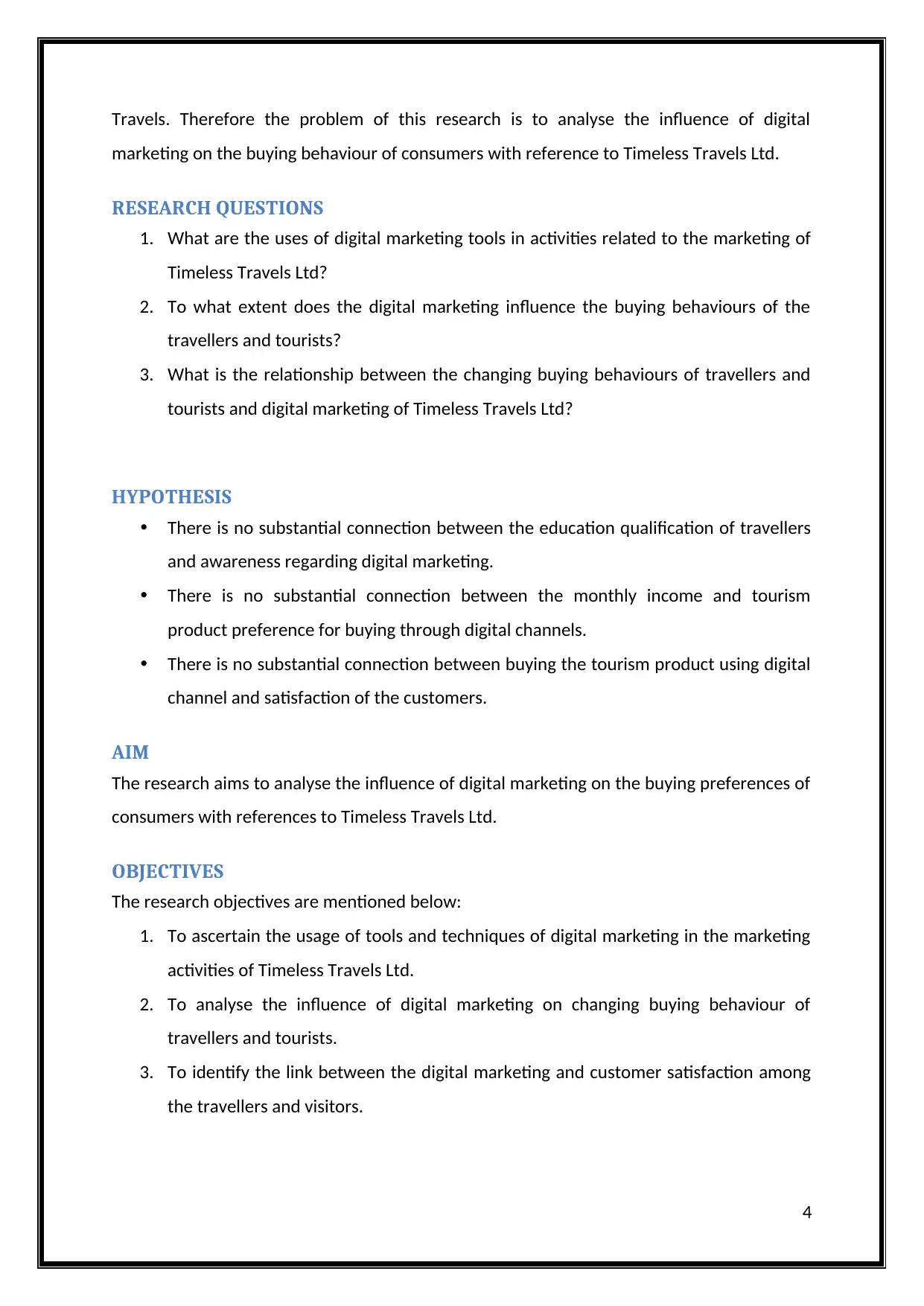
Travels. Therefore the problem of this research is to analyse the influence of digital
marketing on the buying behaviour of consumers with reference to Timeless Travels Ltd.
RESEARCH QUESTIONS
1. What are the uses of digital marketing tools in activities related to the marketing of
Timeless Travels Ltd?
2. To what extent does the digital marketing influence the buying behaviours of the
travellers and tourists?
3. What is the relationship between the changing buying behaviours of travellers and
tourists and digital marketing of Timeless Travels Ltd?
HYPOTHESIS
There is no substantial connection between the education qualification of travellers
and awareness regarding digital marketing.
There is no substantial connection between the monthly income and tourism
product preference for buying through digital channels.
There is no substantial connection between buying the tourism product using digital
channel and satisfaction of the customers.
AIM
The research aims to analyse the influence of digital marketing on the buying preferences of
consumers with references to Timeless Travels Ltd.
OBJECTIVES
The research objectives are mentioned below:
1. To ascertain the usage of tools and techniques of digital marketing in the marketing
activities of Timeless Travels Ltd.
2. To analyse the influence of digital marketing on changing buying behaviour of
travellers and tourists.
3. To identify the link between the digital marketing and customer satisfaction among
the travellers and visitors.
4
marketing on the buying behaviour of consumers with reference to Timeless Travels Ltd.
RESEARCH QUESTIONS
1. What are the uses of digital marketing tools in activities related to the marketing of
Timeless Travels Ltd?
2. To what extent does the digital marketing influence the buying behaviours of the
travellers and tourists?
3. What is the relationship between the changing buying behaviours of travellers and
tourists and digital marketing of Timeless Travels Ltd?
HYPOTHESIS
There is no substantial connection between the education qualification of travellers
and awareness regarding digital marketing.
There is no substantial connection between the monthly income and tourism
product preference for buying through digital channels.
There is no substantial connection between buying the tourism product using digital
channel and satisfaction of the customers.
AIM
The research aims to analyse the influence of digital marketing on the buying preferences of
consumers with references to Timeless Travels Ltd.
OBJECTIVES
The research objectives are mentioned below:
1. To ascertain the usage of tools and techniques of digital marketing in the marketing
activities of Timeless Travels Ltd.
2. To analyse the influence of digital marketing on changing buying behaviour of
travellers and tourists.
3. To identify the link between the digital marketing and customer satisfaction among
the travellers and visitors.
4
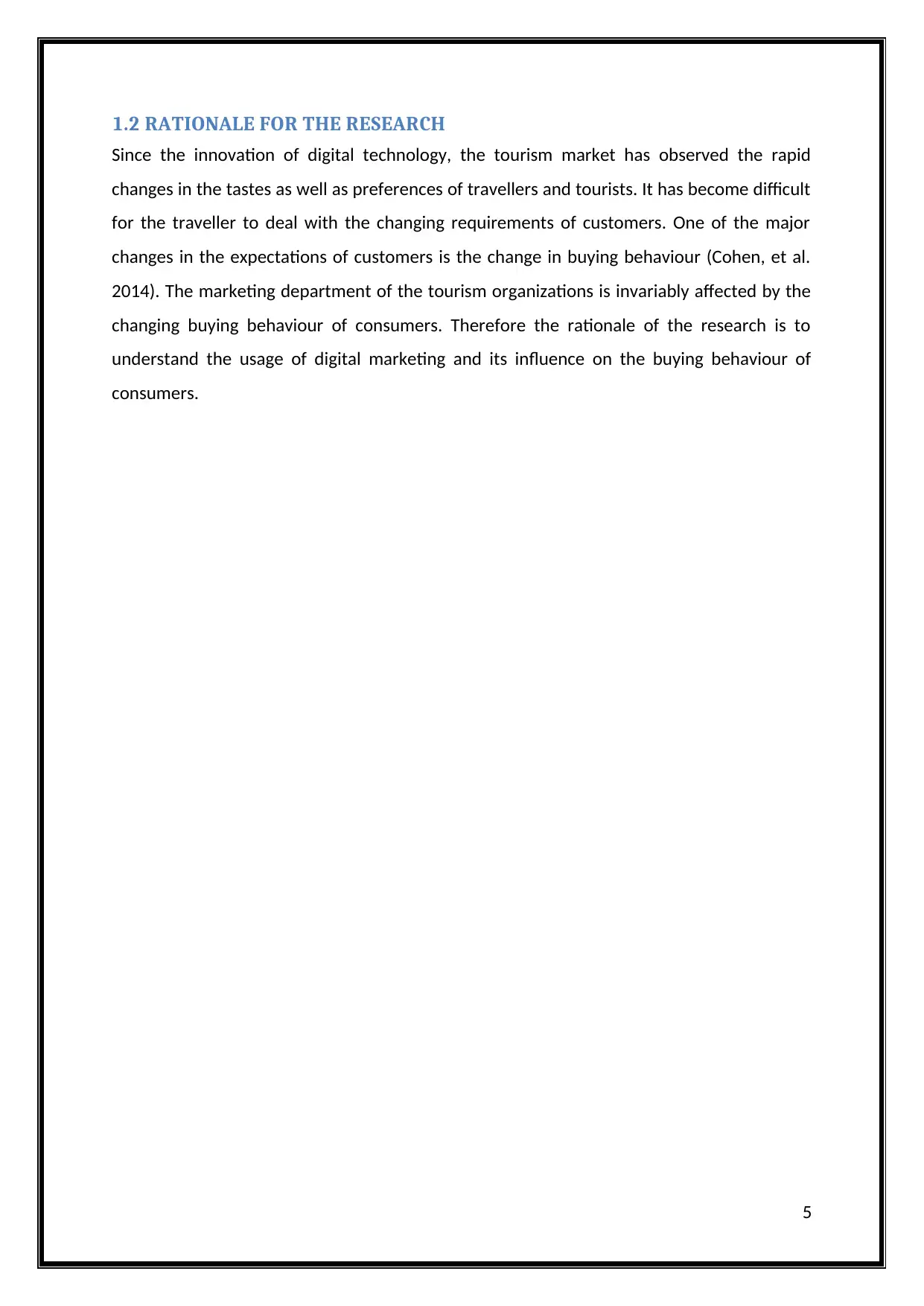
1.2 RATIONALE FOR THE RESEARCH
Since the innovation of digital technology, the tourism market has observed the rapid
changes in the tastes as well as preferences of travellers and tourists. It has become difficult
for the traveller to deal with the changing requirements of customers. One of the major
changes in the expectations of customers is the change in buying behaviour (Cohen, et al.
2014). The marketing department of the tourism organizations is invariably affected by the
changing buying behaviour of consumers. Therefore the rationale of the research is to
understand the usage of digital marketing and its influence on the buying behaviour of
consumers.
5
Since the innovation of digital technology, the tourism market has observed the rapid
changes in the tastes as well as preferences of travellers and tourists. It has become difficult
for the traveller to deal with the changing requirements of customers. One of the major
changes in the expectations of customers is the change in buying behaviour (Cohen, et al.
2014). The marketing department of the tourism organizations is invariably affected by the
changing buying behaviour of consumers. Therefore the rationale of the research is to
understand the usage of digital marketing and its influence on the buying behaviour of
consumers.
5
⊘ This is a preview!⊘
Do you want full access?
Subscribe today to unlock all pages.

Trusted by 1+ million students worldwide
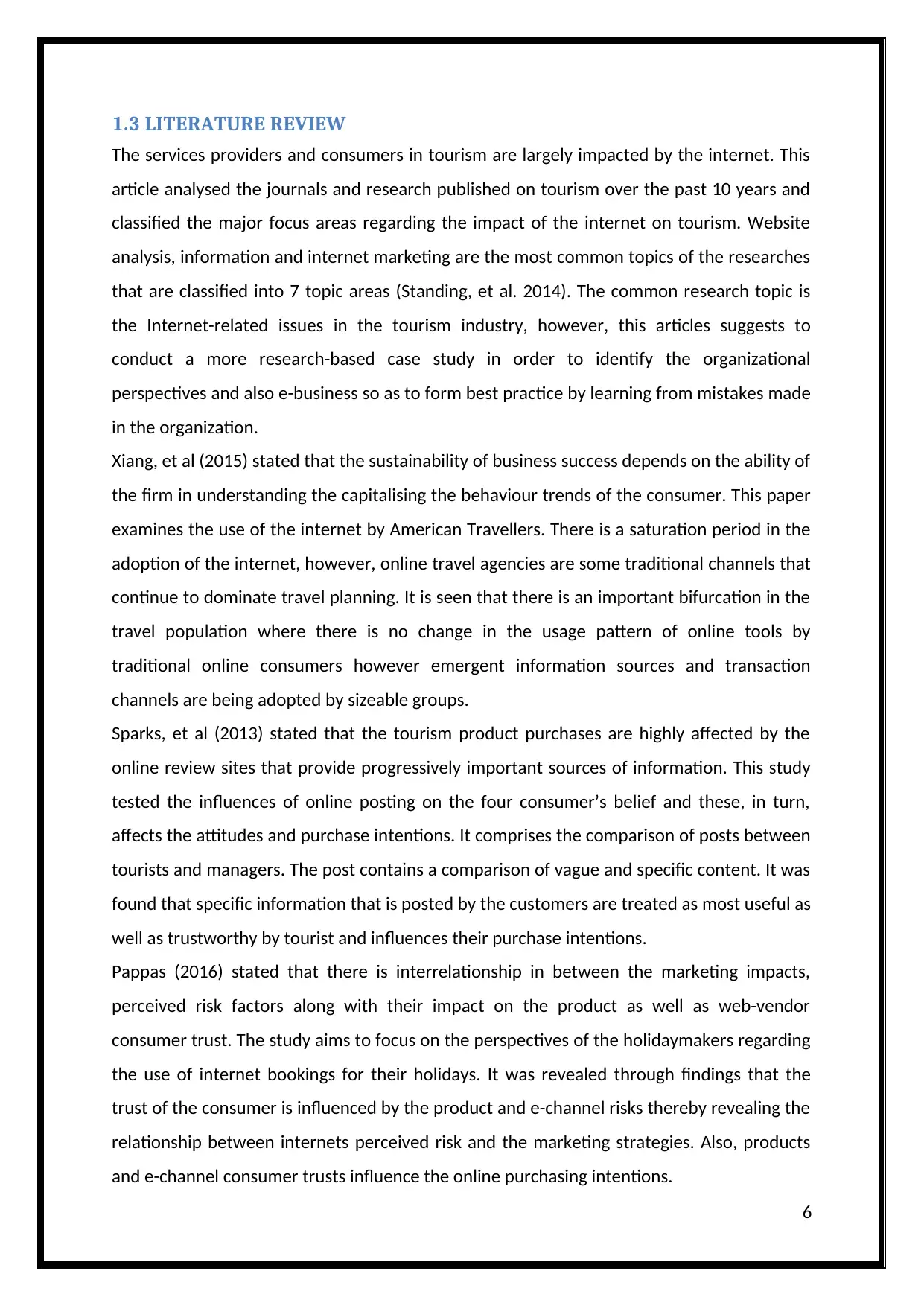
1.3 LITERATURE REVIEW
The services providers and consumers in tourism are largely impacted by the internet. This
article analysed the journals and research published on tourism over the past 10 years and
classified the major focus areas regarding the impact of the internet on tourism. Website
analysis, information and internet marketing are the most common topics of the researches
that are classified into 7 topic areas (Standing, et al. 2014). The common research topic is
the Internet-related issues in the tourism industry, however, this articles suggests to
conduct a more research-based case study in order to identify the organizational
perspectives and also e-business so as to form best practice by learning from mistakes made
in the organization.
Xiang, et al (2015) stated that the sustainability of business success depends on the ability of
the firm in understanding the capitalising the behaviour trends of the consumer. This paper
examines the use of the internet by American Travellers. There is a saturation period in the
adoption of the internet, however, online travel agencies are some traditional channels that
continue to dominate travel planning. It is seen that there is an important bifurcation in the
travel population where there is no change in the usage pattern of online tools by
traditional online consumers however emergent information sources and transaction
channels are being adopted by sizeable groups.
Sparks, et al (2013) stated that the tourism product purchases are highly affected by the
online review sites that provide progressively important sources of information. This study
tested the influences of online posting on the four consumer’s belief and these, in turn,
affects the attitudes and purchase intentions. It comprises the comparison of posts between
tourists and managers. The post contains a comparison of vague and specific content. It was
found that specific information that is posted by the customers are treated as most useful as
well as trustworthy by tourist and influences their purchase intentions.
Pappas (2016) stated that there is interrelationship in between the marketing impacts,
perceived risk factors along with their impact on the product as well as web-vendor
consumer trust. The study aims to focus on the perspectives of the holidaymakers regarding
the use of internet bookings for their holidays. It was revealed through findings that the
trust of the consumer is influenced by the product and e-channel risks thereby revealing the
relationship between internets perceived risk and the marketing strategies. Also, products
and e-channel consumer trusts influence the online purchasing intentions.
6
The services providers and consumers in tourism are largely impacted by the internet. This
article analysed the journals and research published on tourism over the past 10 years and
classified the major focus areas regarding the impact of the internet on tourism. Website
analysis, information and internet marketing are the most common topics of the researches
that are classified into 7 topic areas (Standing, et al. 2014). The common research topic is
the Internet-related issues in the tourism industry, however, this articles suggests to
conduct a more research-based case study in order to identify the organizational
perspectives and also e-business so as to form best practice by learning from mistakes made
in the organization.
Xiang, et al (2015) stated that the sustainability of business success depends on the ability of
the firm in understanding the capitalising the behaviour trends of the consumer. This paper
examines the use of the internet by American Travellers. There is a saturation period in the
adoption of the internet, however, online travel agencies are some traditional channels that
continue to dominate travel planning. It is seen that there is an important bifurcation in the
travel population where there is no change in the usage pattern of online tools by
traditional online consumers however emergent information sources and transaction
channels are being adopted by sizeable groups.
Sparks, et al (2013) stated that the tourism product purchases are highly affected by the
online review sites that provide progressively important sources of information. This study
tested the influences of online posting on the four consumer’s belief and these, in turn,
affects the attitudes and purchase intentions. It comprises the comparison of posts between
tourists and managers. The post contains a comparison of vague and specific content. It was
found that specific information that is posted by the customers are treated as most useful as
well as trustworthy by tourist and influences their purchase intentions.
Pappas (2016) stated that there is interrelationship in between the marketing impacts,
perceived risk factors along with their impact on the product as well as web-vendor
consumer trust. The study aims to focus on the perspectives of the holidaymakers regarding
the use of internet bookings for their holidays. It was revealed through findings that the
trust of the consumer is influenced by the product and e-channel risks thereby revealing the
relationship between internets perceived risk and the marketing strategies. Also, products
and e-channel consumer trusts influence the online purchasing intentions.
6
Paraphrase This Document
Need a fresh take? Get an instant paraphrase of this document with our AI Paraphraser
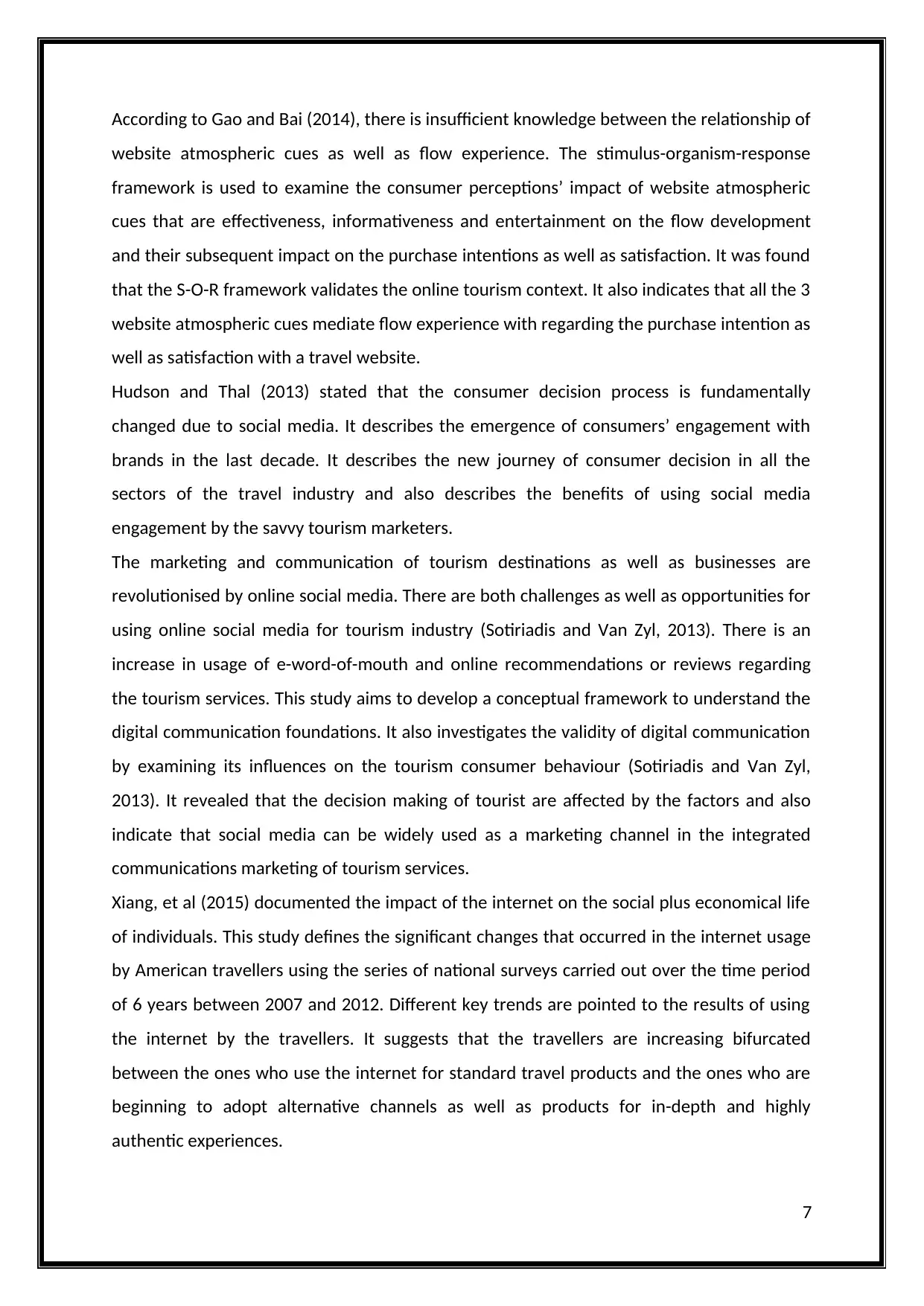
According to Gao and Bai (2014), there is insufficient knowledge between the relationship of
website atmospheric cues as well as flow experience. The stimulus-organism-response
framework is used to examine the consumer perceptions’ impact of website atmospheric
cues that are effectiveness, informativeness and entertainment on the flow development
and their subsequent impact on the purchase intentions as well as satisfaction. It was found
that the S-O-R framework validates the online tourism context. It also indicates that all the 3
website atmospheric cues mediate flow experience with regarding the purchase intention as
well as satisfaction with a travel website.
Hudson and Thal (2013) stated that the consumer decision process is fundamentally
changed due to social media. It describes the emergence of consumers’ engagement with
brands in the last decade. It describes the new journey of consumer decision in all the
sectors of the travel industry and also describes the benefits of using social media
engagement by the savvy tourism marketers.
The marketing and communication of tourism destinations as well as businesses are
revolutionised by online social media. There are both challenges as well as opportunities for
using online social media for tourism industry (Sotiriadis and Van Zyl, 2013). There is an
increase in usage of e-word-of-mouth and online recommendations or reviews regarding
the tourism services. This study aims to develop a conceptual framework to understand the
digital communication foundations. It also investigates the validity of digital communication
by examining its influences on the tourism consumer behaviour (Sotiriadis and Van Zyl,
2013). It revealed that the decision making of tourist are affected by the factors and also
indicate that social media can be widely used as a marketing channel in the integrated
communications marketing of tourism services.
Xiang, et al (2015) documented the impact of the internet on the social plus economical life
of individuals. This study defines the significant changes that occurred in the internet usage
by American travellers using the series of national surveys carried out over the time period
of 6 years between 2007 and 2012. Different key trends are pointed to the results of using
the internet by the travellers. It suggests that the travellers are increasing bifurcated
between the ones who use the internet for standard travel products and the ones who are
beginning to adopt alternative channels as well as products for in-depth and highly
authentic experiences.
7
website atmospheric cues as well as flow experience. The stimulus-organism-response
framework is used to examine the consumer perceptions’ impact of website atmospheric
cues that are effectiveness, informativeness and entertainment on the flow development
and their subsequent impact on the purchase intentions as well as satisfaction. It was found
that the S-O-R framework validates the online tourism context. It also indicates that all the 3
website atmospheric cues mediate flow experience with regarding the purchase intention as
well as satisfaction with a travel website.
Hudson and Thal (2013) stated that the consumer decision process is fundamentally
changed due to social media. It describes the emergence of consumers’ engagement with
brands in the last decade. It describes the new journey of consumer decision in all the
sectors of the travel industry and also describes the benefits of using social media
engagement by the savvy tourism marketers.
The marketing and communication of tourism destinations as well as businesses are
revolutionised by online social media. There are both challenges as well as opportunities for
using online social media for tourism industry (Sotiriadis and Van Zyl, 2013). There is an
increase in usage of e-word-of-mouth and online recommendations or reviews regarding
the tourism services. This study aims to develop a conceptual framework to understand the
digital communication foundations. It also investigates the validity of digital communication
by examining its influences on the tourism consumer behaviour (Sotiriadis and Van Zyl,
2013). It revealed that the decision making of tourist are affected by the factors and also
indicate that social media can be widely used as a marketing channel in the integrated
communications marketing of tourism services.
Xiang, et al (2015) documented the impact of the internet on the social plus economical life
of individuals. This study defines the significant changes that occurred in the internet usage
by American travellers using the series of national surveys carried out over the time period
of 6 years between 2007 and 2012. Different key trends are pointed to the results of using
the internet by the travellers. It suggests that the travellers are increasing bifurcated
between the ones who use the internet for standard travel products and the ones who are
beginning to adopt alternative channels as well as products for in-depth and highly
authentic experiences.
7
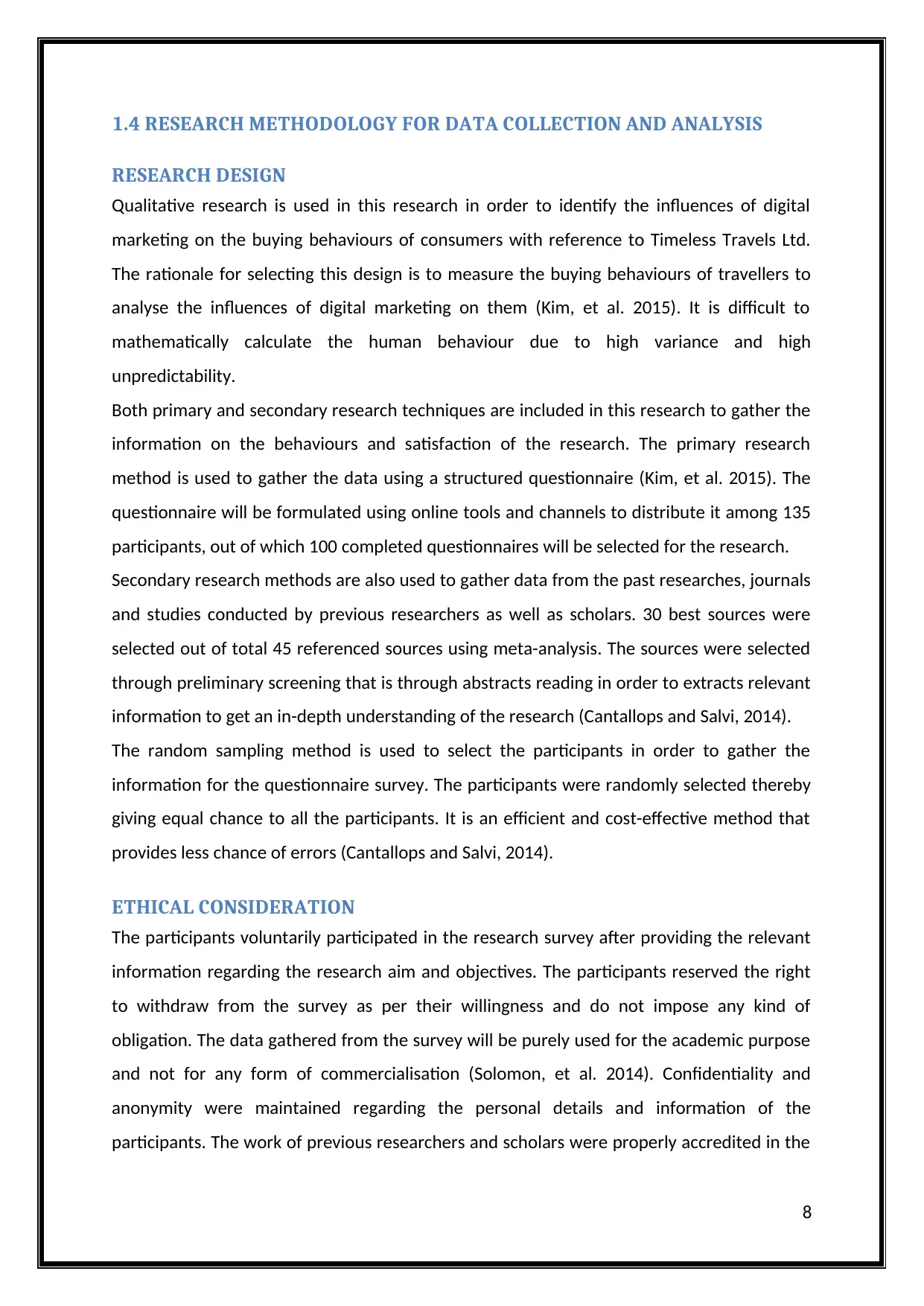
1.4 RESEARCH METHODOLOGY FOR DATA COLLECTION AND ANALYSIS
RESEARCH DESIGN
Qualitative research is used in this research in order to identify the influences of digital
marketing on the buying behaviours of consumers with reference to Timeless Travels Ltd.
The rationale for selecting this design is to measure the buying behaviours of travellers to
analyse the influences of digital marketing on them (Kim, et al. 2015). It is difficult to
mathematically calculate the human behaviour due to high variance and high
unpredictability.
Both primary and secondary research techniques are included in this research to gather the
information on the behaviours and satisfaction of the research. The primary research
method is used to gather the data using a structured questionnaire (Kim, et al. 2015). The
questionnaire will be formulated using online tools and channels to distribute it among 135
participants, out of which 100 completed questionnaires will be selected for the research.
Secondary research methods are also used to gather data from the past researches, journals
and studies conducted by previous researchers as well as scholars. 30 best sources were
selected out of total 45 referenced sources using meta-analysis. The sources were selected
through preliminary screening that is through abstracts reading in order to extracts relevant
information to get an in-depth understanding of the research (Cantallops and Salvi, 2014).
The random sampling method is used to select the participants in order to gather the
information for the questionnaire survey. The participants were randomly selected thereby
giving equal chance to all the participants. It is an efficient and cost-effective method that
provides less chance of errors (Cantallops and Salvi, 2014).
ETHICAL CONSIDERATION
The participants voluntarily participated in the research survey after providing the relevant
information regarding the research aim and objectives. The participants reserved the right
to withdraw from the survey as per their willingness and do not impose any kind of
obligation. The data gathered from the survey will be purely used for the academic purpose
and not for any form of commercialisation (Solomon, et al. 2014). Confidentiality and
anonymity were maintained regarding the personal details and information of the
participants. The work of previous researchers and scholars were properly accredited in the
8
RESEARCH DESIGN
Qualitative research is used in this research in order to identify the influences of digital
marketing on the buying behaviours of consumers with reference to Timeless Travels Ltd.
The rationale for selecting this design is to measure the buying behaviours of travellers to
analyse the influences of digital marketing on them (Kim, et al. 2015). It is difficult to
mathematically calculate the human behaviour due to high variance and high
unpredictability.
Both primary and secondary research techniques are included in this research to gather the
information on the behaviours and satisfaction of the research. The primary research
method is used to gather the data using a structured questionnaire (Kim, et al. 2015). The
questionnaire will be formulated using online tools and channels to distribute it among 135
participants, out of which 100 completed questionnaires will be selected for the research.
Secondary research methods are also used to gather data from the past researches, journals
and studies conducted by previous researchers as well as scholars. 30 best sources were
selected out of total 45 referenced sources using meta-analysis. The sources were selected
through preliminary screening that is through abstracts reading in order to extracts relevant
information to get an in-depth understanding of the research (Cantallops and Salvi, 2014).
The random sampling method is used to select the participants in order to gather the
information for the questionnaire survey. The participants were randomly selected thereby
giving equal chance to all the participants. It is an efficient and cost-effective method that
provides less chance of errors (Cantallops and Salvi, 2014).
ETHICAL CONSIDERATION
The participants voluntarily participated in the research survey after providing the relevant
information regarding the research aim and objectives. The participants reserved the right
to withdraw from the survey as per their willingness and do not impose any kind of
obligation. The data gathered from the survey will be purely used for the academic purpose
and not for any form of commercialisation (Solomon, et al. 2014). Confidentiality and
anonymity were maintained regarding the personal details and information of the
participants. The work of previous researchers and scholars were properly accredited in the
8
⊘ This is a preview!⊘
Do you want full access?
Subscribe today to unlock all pages.

Trusted by 1+ million students worldwide
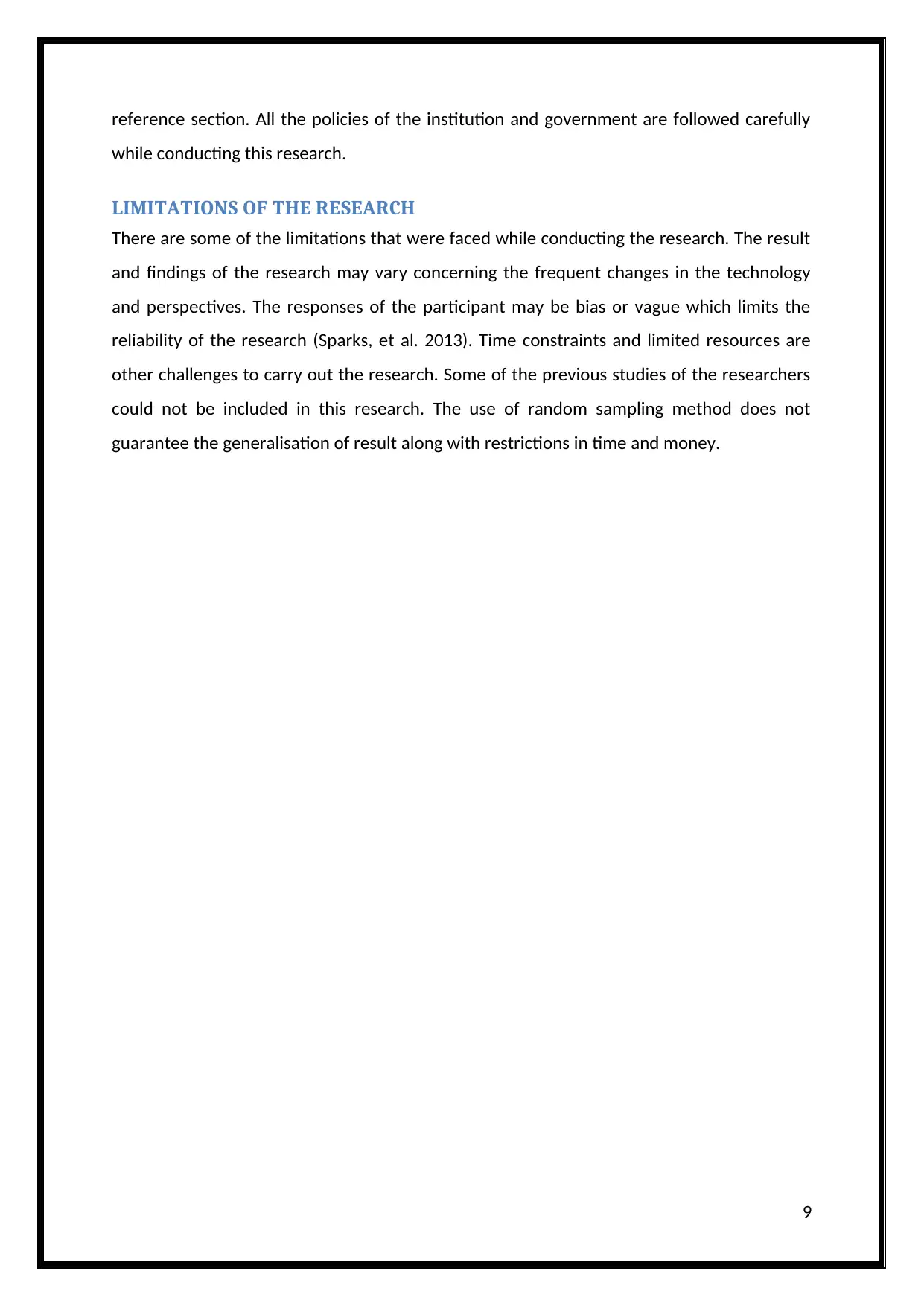
reference section. All the policies of the institution and government are followed carefully
while conducting this research.
LIMITATIONS OF THE RESEARCH
There are some of the limitations that were faced while conducting the research. The result
and findings of the research may vary concerning the frequent changes in the technology
and perspectives. The responses of the participant may be bias or vague which limits the
reliability of the research (Sparks, et al. 2013). Time constraints and limited resources are
other challenges to carry out the research. Some of the previous studies of the researchers
could not be included in this research. The use of random sampling method does not
guarantee the generalisation of result along with restrictions in time and money.
9
while conducting this research.
LIMITATIONS OF THE RESEARCH
There are some of the limitations that were faced while conducting the research. The result
and findings of the research may vary concerning the frequent changes in the technology
and perspectives. The responses of the participant may be bias or vague which limits the
reliability of the research (Sparks, et al. 2013). Time constraints and limited resources are
other challenges to carry out the research. Some of the previous studies of the researchers
could not be included in this research. The use of random sampling method does not
guarantee the generalisation of result along with restrictions in time and money.
9
Paraphrase This Document
Need a fresh take? Get an instant paraphrase of this document with our AI Paraphraser
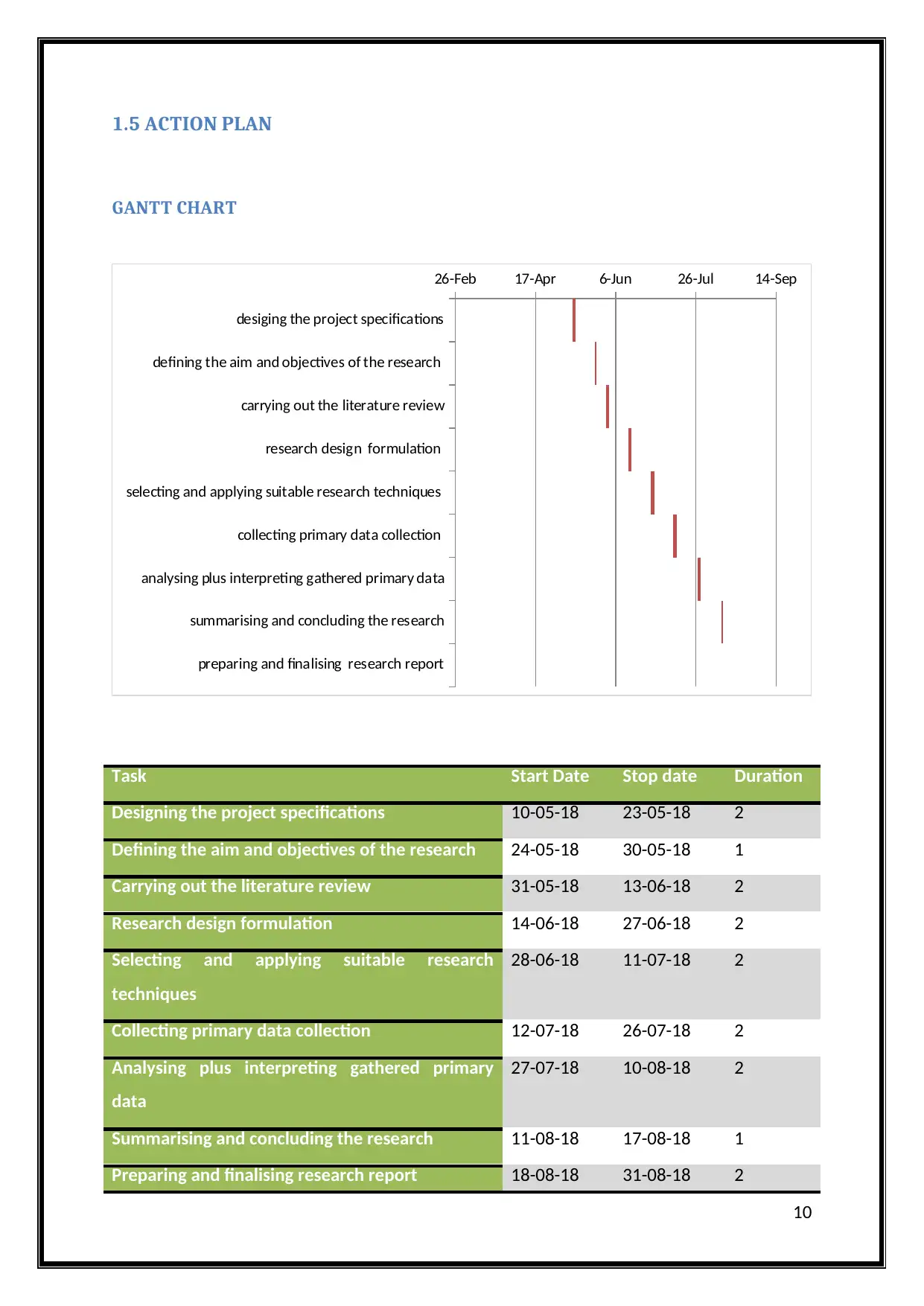
1.5 ACTION PLAN
GANTT CHART
desiging the project specifications
defining the aim and objectives of the research
carrying out the literature review
research design formulation
selecting and applying suitable research techniques
collecting primary data collection
analysing plus interpreting gathered primary data
summarising and concluding the research
preparing and finalising research report
26-Feb 17-Apr 6-Jun 26-Jul 14-Sep
Task Start Date Stop date Duration
Designing the project specifications 10-05-18 23-05-18 2
Defining the aim and objectives of the research 24-05-18 30-05-18 1
Carrying out the literature review 31-05-18 13-06-18 2
Research design formulation 14-06-18 27-06-18 2
Selecting and applying suitable research
techniques
28-06-18 11-07-18 2
Collecting primary data collection 12-07-18 26-07-18 2
Analysing plus interpreting gathered primary
data
27-07-18 10-08-18 2
Summarising and concluding the research 11-08-18 17-08-18 1
Preparing and finalising research report 18-08-18 31-08-18 2
10
GANTT CHART
desiging the project specifications
defining the aim and objectives of the research
carrying out the literature review
research design formulation
selecting and applying suitable research techniques
collecting primary data collection
analysing plus interpreting gathered primary data
summarising and concluding the research
preparing and finalising research report
26-Feb 17-Apr 6-Jun 26-Jul 14-Sep
Task Start Date Stop date Duration
Designing the project specifications 10-05-18 23-05-18 2
Defining the aim and objectives of the research 24-05-18 30-05-18 1
Carrying out the literature review 31-05-18 13-06-18 2
Research design formulation 14-06-18 27-06-18 2
Selecting and applying suitable research
techniques
28-06-18 11-07-18 2
Collecting primary data collection 12-07-18 26-07-18 2
Analysing plus interpreting gathered primary
data
27-07-18 10-08-18 2
Summarising and concluding the research 11-08-18 17-08-18 1
Preparing and finalising research report 18-08-18 31-08-18 2
10
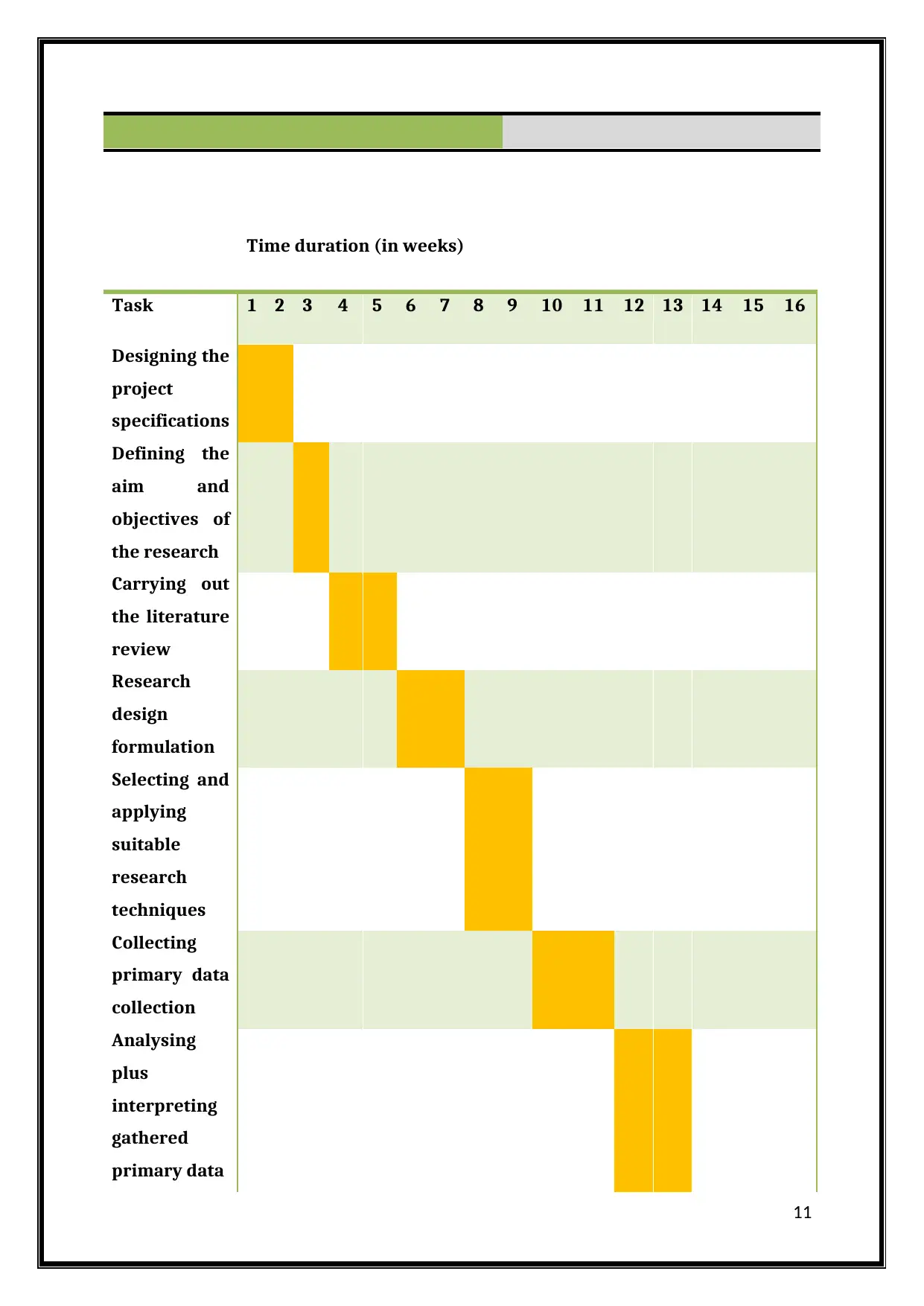
Time duration (in weeks)
Task 1 2 3 4 5 6 7 8 9 10 11 12 13 14 15 16
Designing the
project
specifications
Defining the
aim and
objectives of
the research
Carrying out
the literature
review
Research
design
formulation
Selecting and
applying
suitable
research
techniques
Collecting
primary data
collection
Analysing
plus
interpreting
gathered
primary data
11
Task 1 2 3 4 5 6 7 8 9 10 11 12 13 14 15 16
Designing the
project
specifications
Defining the
aim and
objectives of
the research
Carrying out
the literature
review
Research
design
formulation
Selecting and
applying
suitable
research
techniques
Collecting
primary data
collection
Analysing
plus
interpreting
gathered
primary data
11
⊘ This is a preview!⊘
Do you want full access?
Subscribe today to unlock all pages.

Trusted by 1+ million students worldwide
1 out of 37
Related Documents
Your All-in-One AI-Powered Toolkit for Academic Success.
+13062052269
info@desklib.com
Available 24*7 on WhatsApp / Email
![[object Object]](/_next/static/media/star-bottom.7253800d.svg)
Unlock your academic potential
Copyright © 2020–2025 A2Z Services. All Rights Reserved. Developed and managed by ZUCOL.




